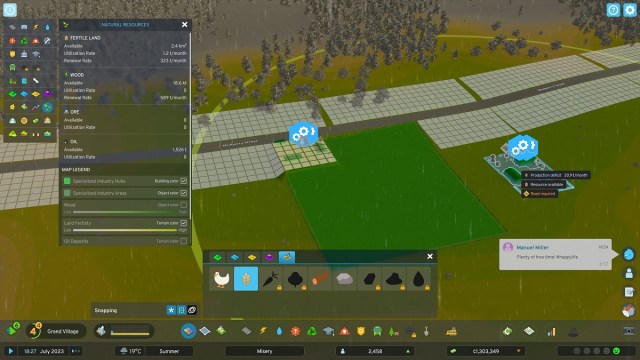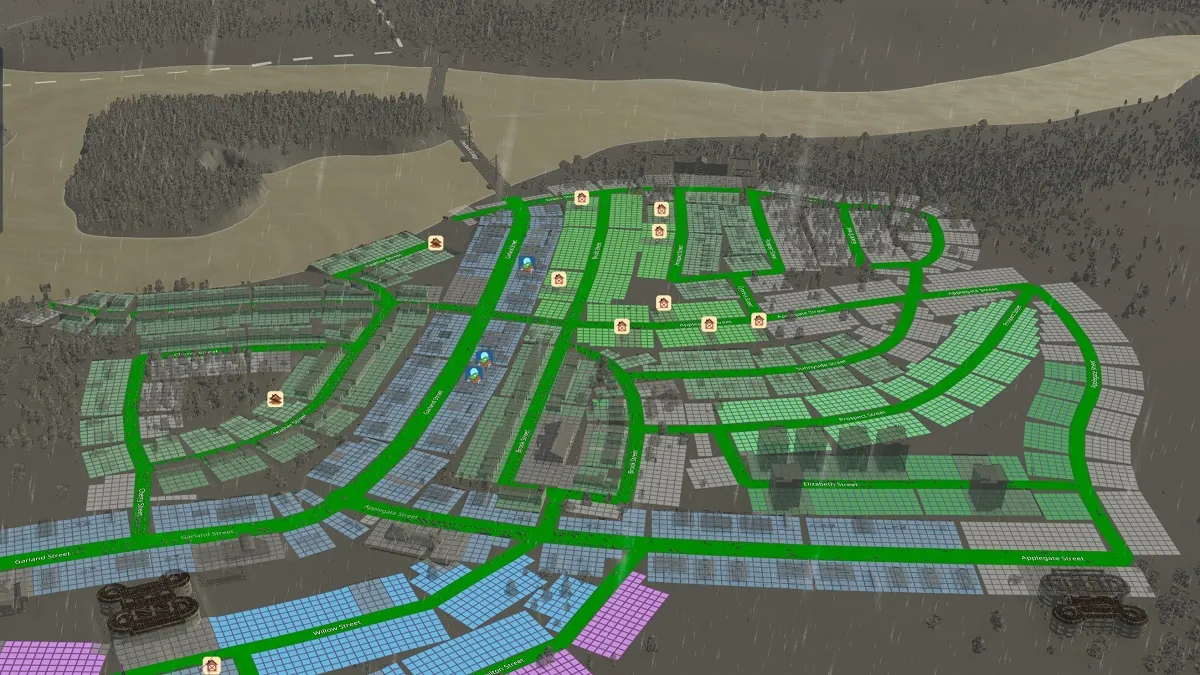Zoning is one of the most basic concepts of urban development games, going back as far as 1989’s SimCity. It’s based on real-world zoning, but if you’re not in real estate or a municipal government, you might not really notice it. There are no signs that tell you what zone you’re in.
While historically, city builders focus on the RCI (Residential, Commercial, Industrial) designations, Cities: Skylines 2 goes beyond that with the addition of Office and “specialized industry.” Specialized industry itself is broken into a number of different zoning subsets. They aren’t too complicated, however, so we’ll take them as we go.
Zoning is done simply by picking what you want to zone for and smacking it down next to a road. Note that for your specialized industry, you’ll need to ensure that the resource is available where you’re placing it.
One thing you’ll want to note is the RCI scale on your HUD. Pay attention to it because it will tell you what is in demand and what you should be zoning for.
Residential
Residential areas are where people live. While none of the zones are more important than another, this is the one you need to start with. Before you can have industry or sell goods, you need people.
Residential comes in a few flavors, but they can be broken down into low, medium, and high density. Essentially, this means houses, low-rises, and high-rises. There are also lower-income variants to these.
To build a successful city, you’re going to need all of the above. Not everyone wants to live in a house, nor do they want to live in a highrise. Wealth is a good thing for your city, but rich people don’t typically want to work in industry. You have to cater to everyone.
Commercial
Commercial is where goods and services are sold. Goods come from your industry and support your residents. As such, it’s sort of the middle ground of the three main zones. It’s where your industry and residential meet.
If you don’t have enough industry to satisfy the needs of your residents, supplies will be brought in from outside connections. While trade is perfectly fine, if you rely too heavily on it, you’ll find your streets clogged up with transportation traffic, and commercial areas will be unable to restock and meet the needs of your people. I’m probably making it sound more stressful than it really is.
Industrial
Industrial is where goods are processed and manufactured. To put it simply, these are factories. Not only do they supply the commercial areas of your city (and thus, your residents), they are also a place to work. As such, a solid industrial area is the second task you should have in terms of zoning.
There are a few things you should keep in mind here. First, you’ll want to build your industry in isolated areas near highways and railways. The isolation is important because factories cause a lot of pollution (both ground and water). Transportation is important because a lot of stuff from your factory will be going to and coming from outside connections.
Speaking of which, it’s helpful if you have specialized industry in your city to support your factories. Factories process resources, so if you are producing the resources within your city limits, you don’t have to clog up your highways with incoming commodities.
Offices
Offices are where educated people work because they’re too good for a retail job. Cities: Skylines 2 defines offices as a place where “immaterial” goods and services are produced. Whatever that means.
The important thing is that these are key to keeping your affluent and educated residents affluent. Since they don’t require goods to be delivered or picked up, they can be built on narrow roads. You will probably want to provide parking and public transportation for them, however.

Specialized industry
Specialized industry is where resources are produced. In the case of things like farms, oil, and ore, you’re going to need to place these where the resources are available (they’ll appear when you select the zone). However, there are others, like livestock and stone, that can be dropped any old place. However, you will need to assign space to them after you drop down the building. This will mean drawing out the boundaries of where you want the zone.
Like normal industry, it’s important to have these near highway access. Anything not delivered to your manufacturing will be shipped off to outside connections.






Published: Oct 24, 2023 03:29 pm